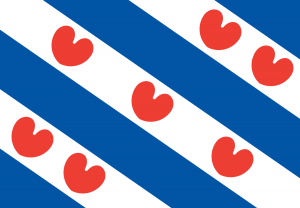Language/Western-frisian/Vocabulary/Geography
Hi Western Frisian learners! 😊
In this lesson, we will focus on expanding our Western Frisian vocabulary related to geography. To reinforce the new vocabulary, we will also include some cultural information and interesting facts. Don't forget that to improve your Western Frisian vocabulary, you can also use the Polyglot Club website. Find native speakers and ask them any questions!
Landforms[edit | edit source]
In Western Frisian, there are many different words to describe the landforms found all around the world. Let's take a look at some examples:
| Western Frisian | Pronunciation | English |
|---|---|---|
| berg | bɛrx | mountain |
| heide | hɛ:də | moorland |
| heuvel | hø:vəl | hill |
| klif | klɪf | cliff |
| eilân | ɛ:lɔ:n | island |
| kust | kœst | coast |
Let's try these words in a dialogue:
- Person 1: Sjoch ris nei dat grutte kleaster op dat begjinhof op de top fan 'e bult. (Look at that big monastery on that convent on top of the hill.)
- Person 2: En wat oer de kliften? (And what about the cliffs?)
- Person 1: Ja, it bestjoer tusken de kust en de klif is yndrukwekkend. (Yes, the contrast between the coast and the cliff is impressive.)
Bodies of water[edit | edit source]
Water is essential to life and plays a significant role in Western Frisian culture, surrounded by both sea and freshwater. Let's explore some of the vocabulary used in regards to bodies of water:
| Western Frisian | Pronunciation | English |
|---|---|---|
| see | se:x | sea |
| oseaan | o:ʃean | ocean |
| stream | strim | stream |
| rivier | riviər | river |
| mar | mɑr | lake |
Here's an example of a dialogue that includes some words about water:
- Person 1: De see is hjoed heech en grut. (The sea is high and big today.)
- Person 2: Dat is sa omdat wy hjoed by de oseaan binne en dy is twa kear sa grut as de See fan 'e Middellânske See. (That's because we are at the ocean today, and it's twice as big as the Mediterranean Sea.)
- Person 1: Wat is dêr oan 'e oare kant fan 'e stream? (What is on the other side of the stream?)
- Person 2: Der is in prachtige rivier mei fisk der yn. (There is a beautiful river with fish in it.)
Directions[edit | edit source]
When navigating through unknown terrain, it is essential to know your way around. Here's some vocabulary to help you find your way:
| Western Frisian | Pronunciation | English |
|---|---|---|
| noarden | nuɔrdən | north |
| easten | ø:stən | east |
| suden | sydən | south |
| westen | wɛstən | west |
| bolleboartersguod | bɔləbo:rtərsgu:d | compass |
Let's put it all together in a dialogue:
- Person 1: Wy moatte nei it suden gean om by it mar te kommen. (We need to go south to get to the lake.)
- Person 2: Ik tink dat it mar mear yn it easten leit. (I think the lake is more towards the east.)
- Person 1: Hast in bolleboartersguod by dy? (Do you have a compass with you?)
- Person 2: Ja, hjir is er. Wy geane no yn de rjochting fan it westen. (Yes, here it is. We are now walking towards the west.)
Interesting Facts[edit | edit source]
Did you know, that Western Frisian is spoken by only 350,000 native speakers? Western Frisian is spoken in the province of Friesland (Fryslân), located in the northern part of the Netherlands. Friesland has its language and culture, including traditional clothing, music, and food. The region is well-known for its scenic countryside, with vast fields, meadows, and endless waterways.
➡ If you have any questions, please ask them in the comments section below.
➡ Feel free to edit this wiki page if you think it can be improved. 😎

